Webster’s disctionary defines Character as “a distinctive trait, quality or attribute.”
That certainly applies to a significant number of bears in our collecting world, such as Smoky Bear, Teddy B & Teddy G, and a host of others.
For this feature we thought it would be fun to focus on five of our favorite character bears that originated in Great Britain.
WINNIE-THE-POOH
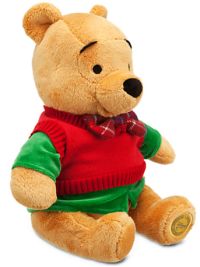 If you had to rate character bears by their popularity, one stands head and shoulders above all the others by any measurement. If you had to rate character bears by their popularity, one stands head and shoulders above all the others by any measurement.
Winnie the Pooh unquestionably has the largest following. generates the largest sales figures and is a household word around the world.
Some news reports suggest that this loveable character provides in excess of a Billion dollars in licensed product sales a year to Disney alone, and when you factor in the movies, books and other licensing sources, that figure is estimated to be 3 to 6 Billion dollars worldwide!
Pooh’s story actually started in 1921 when A.A. Milne’s son Christopher Robin was celebrating his first birthday and received a beautiful teddy bear as a gift. At first the bear was called Edward, but young Christopher was fond of visiting the London Zoo wher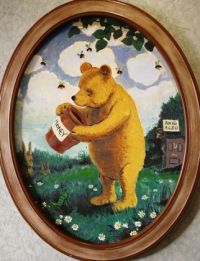 e he admired a Canadian black bear named Winnie. The young lad also acquired other stuffed animals, and this led his father to write a series of stories and books for children. In 1925 the first Pooh story was published, and several books followed, all with record sales within a short time frame. e he admired a Canadian black bear named Winnie. The young lad also acquired other stuffed animals, and this led his father to write a series of stories and books for children. In 1925 the first Pooh story was published, and several books followed, all with record sales within a short time frame.
Pooh’s fame continued to grow, and Walt Disney was quick to realize the potential of this beloved bear. In 1961 Disney acquired the rights to Winnie the Pooh from Milne’s widow. The characters were given a Disney makeover, and the rest is history. It should be noted that the British Classic Pooh remains true to the original drawings by E.H. Shepard.
PADDINGTON
 Paddington was born in Peru, where he lived with his parents. That’s the story line by Michael Bond, this loveable British bear’s creator. Paddington was born in Peru, where he lived with his parents. That’s the story line by Michael Bond, this loveable British bear’s creator.
In the mid 1950s, Bond had to buy a last minute Christmas gift and saw a bear sitting all alone on a shelf and the bear went home with him.
The first Paddington book came along in 1956 and his popularity was established almost immediately.
Paddington is easily recognized by his coat and oversize hat, and he always wears a tag that reads “Please look after this bear.”
It seems Paddington stowed away on a boat and traveled all the way from Peru to London, where he was discovered by the Brown family. This was the beginning of a love affair between Paddington and the children of the world that has lasted to this very day.
SOOTY
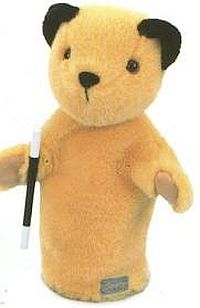 Another popular British character teddy bear that was introduced in the 1960s is a puppet named Sooty. Another popular British character teddy bear that was introduced in the 1960s is a puppet named Sooty.
He was so named because of his trademark black ears that likely came about from soot.
A gentleman named Harry Corbett purchased a lovely puppet bear in 1948 to entertain his children.
In 1952 Harry and Sooty made their first appearance on the BBC’s Talen Night television show. That same year they were featured regularly on a children’s television program, and by 1955 Sooty had his very own show.
Other characters joined the show in subsequent years, including Sweep the dog, Soo (a Panda girlfriend), and several others. By 1996 Sooty became a cartoon series. He is fondly remembered by most British people who grew up in the 1950s to the 1970s era.
RUPERT
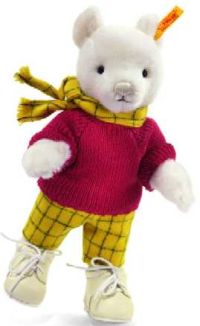 Another character bear that can claim Britain as his home is Rupert, an adventurous bear that first made an appearance in the English newspaper the Daily Express in 1920. Another character bear that can claim Britain as his home is Rupert, an adventurous bear that first made an appearance in the English newspaper the Daily Express in 1920.
Mary Tourtel, the wife of one of the editors, was asked to create a comic strip for the paper. Her creation was Rupert bear, who was introduced in a November 8 issue. He became a daily feature, with 2 drawings and a short story.
Over the years Rupert has been joined in his adventures by a number of characters, including Bill Badger, Podgy Pig, Algy Pug, Pong Ping and others.
Rupert is easily identified in his traditional garb of striped yellow pants, red sweater and striped yellow scarf. In addition to the daily comic strip, Rupert was featured in an Annual published by the paper that was a collection of all the Rupert strips from the previous 12 months. This annual is prized by Rupert fans today, along with various plush bears in his image and numerous other Rupert memorabilia.
CHEEKY
 The British teddy bear firm of Merrythought has a great variety of teddy designs, but one of their all time favorites with collectors has been a bear named Cheeky. The British teddy bear firm of Merrythought has a great variety of teddy designs, but one of their all time favorites with collectors has been a bear named Cheeky.
He was introduced in 1956 and is recognizable by his oversize ears that hang on the side of a large round head.
Cheeky also has a velvet muzzle and he has bells tucked inside his ears.
Over the years, Merrythought has produced Cheeky in art silk plush, mohair and gold plush. Some have had musical movements.
He has also been crafted as a glove puppet and as a child’s muff, but more typically he is in the traditional teddy bear form.
Devoted Cheeky collectors will point out that a bear named Punkinhead is considered the forerunner to Cheeky.
Punkinhead was made for Eatons Department store in Canada in 1950 and featured a very distinctive top knot of hair. Because he was made in limited quantities for such a short time frame, prime examples of Punkinhead command strong prices on the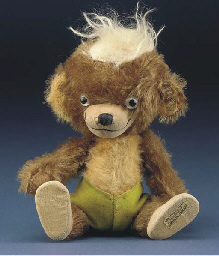 secondary market today. secondary market today.
This rare
Punkinhead bear by Merrythought sold at a Christie'sauction recently for $1,373.00!
Whether your collection is centered on just one of these characters, or is more broadly based on all of them, collecting character bears with a British accent is an exciting hobby. |


 3428 Hillvale Road
3428 Hillvale Road  Louisville, KY 40241 USA
Louisville, KY 40241 USA